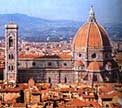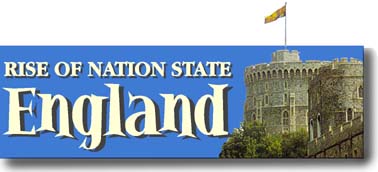Richard I the Lion Heart (1189 - 1199)
The crown of England passed from Henry II to his 32-year-old son
Richard, a.k.a. Lion Heart. Richard I had spent six months of his
ten-year-reign abroad.

A page from the Latin chronicle describing the coronation
of Richard I.

The "Saucy Castle" was built under the
supervision of Richard I in the 1190s.
Philip II of France seized the castle from King John in 1204.
Palestine
Palestine was under the rule of Muslims in the 7th century. Christian
pilgrims from Europe were not stopped from visiting there. During
the 11th century, the situation changed. Palestine and the neighboring
countries of Syria and Asia Minor were overrun by Turks from the
great plains of central Asia. These Turks were Muslims, like the
Arabs, but they were not so willing to live in peace with Christians.
Pope Urban
In November 1095, Pope Urban held a Church Council at Clermont in
France. Speaking with great passion, he urged the proud nobles and
knights of Europe to go and free Byzantium and the Holy Land from
the Saracens, as Muslims were often called. Peter the Hermit and
the Pope started the first Crusade. Cleverly, Pope Urban II said
that he would forgive the sins of all people who went and fought
in the Holy Land.
Pope Urban urged:
"Christ himself will be your leader
... Wear his cross as your badge. If you are killed your sins will
be pardoned ... Let those who have been fighting against their own
brothers and kinsfolk now fight lawfully against the barbarians."
As Urban spoke, there was a great shout of "Deus le volt!" (God
wills it!). Knights welcomed heavenly salvation with their swords.
All volunteers sewed large crosses on their clothing. Latin for
cross is "crux," where we get crusade (war of the cross).

Pope Urban II preaches the First Crusade at the Council
of Clermont in 1095.
In order to join the crusade, William I's eldest son, Robert, pawned
Normandy to his brother William II.
Jerusalem Captured
Jerusalem was captured. Jerusalem was in Christian hands and all
of Europe rejoiced. Most of the crusaders returned home, but a few
hundred knights settled on the conquered lands in Palestine and
Syria. The Muslim population had to pay taxes and give half their
crops to the crusader settlers. Duke Godfrey became ruler of Jerusalem
and overlord of the other Christian territories. He refused to be
called king, saying he would not have a royal crown in the city
where Jesus had worn the crown of thorns. But, Godfrey soon died
and his brother Baldwin took the title of King of Jerusalem in 1100.
Sultan Saladin / Third Crusade
Edessa and the surrounding area were recaptured by the Saracens
in 1144. During the next 40 years, the Kingdom of Jerusalem grew
steadily weaker. Finally in 1187, the Turkish Sultan Saladin overwhelmed
the crusader-settlers in a battle near the Sea of Galilee. When
news of the disaster reached Europe a Third Crusade was organized.
To raise money for ships, soldiers and equipment, Richard put heavy
taxes on his subjects.
"I would sell the city of London,
if only I had a buyer."
- Richard I

Left: Richard I is shown mounted for combat during
the Third Crusade.
Right: His adversary, Saladin the Saracen.
They arrived at Acre to find the other crusaders already besieging
it. Some were in a poor way, suffering from fever, but Richard's
appearance gave them fresh heart. The first great obstacle had been
overcome. Philip decided he had done enough. He returned to France,
leaving behind 10,000 knights under the Duke of Burgundy. Philip
had no real interest in crusading. Richard had outshone him as a
soldier.

The knight at the left bears the arms of Richard
I, while the shield of the knight
on the right represents the infidel Saladin.
King Richard's Adventures
They were twelve miles from Jerusalem. Richard was now so short
of men and supplies that he was unable to attack it. He got within
sight of its walls, but he shielded his eyes and refused to look,
knowing he could not capture the Holy City. Then, there was some
bad news for Richard. His brother John was plotting with Philip
of France and his kingdom was in danger.

A grim scene of Richard Coeur de Lion massacring
his Saracen hostages in the Holy Land. From his balcony, Richard
complacently observes the gruesome spectacle. Headless corpses are
piled up beneath a platform on which two blindfolded men are about
to be beheaded. Others await their turn, while soldiers lead the
next victims to the ladder. Click
painting for an enlargement.
The Crusaders set sail for home, but Richard's adventures did not
end there. While traveling overland from Venice, he was arrested
by Duke Leopold of Austria. They were enemies, despite fighting
together on the crusade. Richard was handed over to the German emperor,
Henry VI, who claimed 150,000 silver marks as ransom. (Equal to
millions of dollars today.)
Richard was released after 13 months of imprisonment. He returned
to England and punished those who had supported his rebellious brother,
John. Two months later, he sailed for France, where Philip had taken
advantage of his absence to attack his lands. Richard was furious
and determined to recover his losses from a fellow crusader. One
by one Lion-heart recaptured his castles.
Richard met an untimely death. Carelessly, he rode without full
armor near the walls of a besieged town and was struck in the shoulder
by a bolt from a cross-bow. The wound turned septic and he died
in 1199.

Tomb-effigy of King Richard I at Fontevrault Abbey.
Fourth Crusade
The Fourth Crusade never reached the Holy Land. In 1229, Jerusalem
was recovered by Emperor Frederick II of Germany. Rather than fight
the Saracens, he made peace with them. Jerusalem remained in European
hands for 15 years, but was lost for good in 1244.
The Children's Crusade
In 1212, the Children's Crusade was led by a French shepherd boy
of 12, who believed that God had chosen him to free the Holy Land
from the Turks! He persuaded thousands of children to follow him
to Marseilles, where some dishonest seamen promised to transport
his army. Some died in shipwrecks. The rest were sold in the Saracen
slave markets.

A 15th-century map depicting the saintly King Louis
IX of France
on the Seventh and Eighth Crusades. Louis IX stops at various cities
in
his pursuit of the infidel, finally succumbing to plague at Tunis.
Click the map for an enlargement.
For more information about the Crusades,
please see:
The Roman Catholic Church in the Middle
Ages
On returning to Europe, some educated crusaders helped
to spread the superior knowledge of the Muslims - especially in
medicine, math, and architecture. During the Crusades, European
people learned more about the eastern parts of the world. When they
returned to Europe, they took back with them many new things including
foods, spices, silk, and paper. They learned about medicine, mathematics,
and astronomy from the Arabs, and trade between east and west began
to grow.



![]() 9375 South Cresthill Lane
9375 South Cresthill Lane ![]() Highlands Ranch, Colorado 80126
Highlands Ranch, Colorado 80126 ![]() 303-471-7000
303-471-7000








